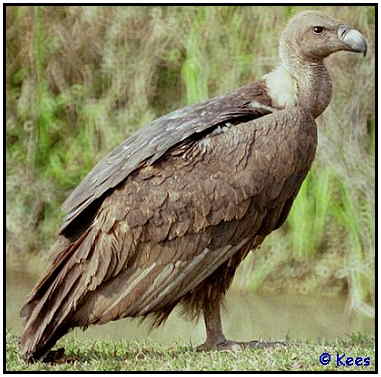Asian White-BackedOrder: Falconiformes. Family: Accipitridae. (Old World vulture). Scientific Name: Gyps bengalensis. Common Names: Asian White-backed Vulture, Indian White-backed Vulture, or Indian White-rumped Vulture. Conservation Status: Threatened. Over the past three years a continuing massive decline in vulture numbers has occurred in India. This is thought to be due to a virus, the increasing use of pesticides, poisoned carcasses, calcium deficiency in chicks, or an increasing trend towards burying carcasses rather than leaving them lying. Of these options it seems the virus is the most likely option. The birds appear sick prior to dying and simply perch on the branch of a tree. They appear to be drowsy and frequently dose off with the neck limp and hanging. After a time vultures awake with a start and pull their neck in again, only for the process to be repeated minutes later. This can be observed over a period of four or five days after which time the birds fall off their perch and die. Autopsies
have been carried out on two birds found dead or dying; this showed
that the liver and other internal organs were covered with whitish
crystals assumed to be uric acid. The situation regarding the Asian
White-backed Vulture is now regarded as critical with extinction
inevitable unless the reasons responsible for their population decline
can be ascertained and corrected. Bird loss now exceeds 95% in some
portions of their range. (The Long-billed Griffon has been as severely
affected and is also considered to be endangered). Rescue & Recovery: It is hoped that between European and North American zoos enough birds will be found to form a sustainable breeding nucleus. At this stage it appears captive birds will breed successfully and fertile eggs have already been produced. Geographical Range: West and east Africa, Nambia, Botswana, Zimbabwe, Transvaal and Zululand. Habitat: Savannah regions and relatively wet habitats. Physical Characteristics: Predominantly dull brown, but with a patch of white feathers over the lower back or rump. Bald brown head with a narrow collar of white feathers. A long thin neck and bill enables the Asian White-backed Vulture to get right inside carcasses to feed.
Asian White-Backed Vulture (Photograph Courtesy of Kees Bakker Copyright ©2000)Food: This is usually the most numerous vulture at a carcass, but it is rarely the first to approach. They are careful birds which spend sometime cruising overhead, or perched on nearby trees to ascertain that everything is safe. With the amazing ability to fill their crops within only five to eight minutes, 100 of these birds can strip a fifty kilogram carcass clean in only three minutes. They positively relish entrails and have particularly long necks allowing them to push their heads right inside the carcass to get at the juiciest morsels. Though almost exclusively carrion feeders, there is one recorded incident of an ailing calf being attacked. The calf managed to raise the strength to kill the vulture before then dying itself. Reproduction: The Asian White-Backed Vulture builds a stick nest in tall trees, sometimes two nests will be found per tree and often a group of trees may contain ten breeding pairs. These colonies seem to be located in lion country, probably as the birds know this is an easy source of food to feed their chicks. The Asian White-backed Vulture breeds in winter and lays a single white egg from April to July. Parents share incubation (56 to 58 days) and for the first fifty days of its life one parent stays in attendance while the other goes off to forage. A sharp decline has been recorded in breeding success over the past decade. A dramatic drop in breeding success has been recorded in this bird, with a study at Keoladeo National Park showing that in 1985-86 success was as high as 82%, but in the period from 1987-99 success was nil. Other: All New and Old World vultures are flight specialists and may cruise hundreds of kilometres each day with very little effort. They have broad wings and the primary feathers spread in such a manner as to give them a great deal of lift, even at very low speeds. Flight involves soaring up as high as 2,000 metres, then simply gliding over several kilometres from one thermal to the next. The thermals are used to spot carrion and get there before other animals arrive. Calculations have shown that the Asian White-backed Vulture uses one-thirtieth of the energy required for flapping flight. When the heaviest vultures and condors use flapping flight it requires so much extra energy that they are barely able to stay aloft, in fact it is considered almost impossible for them to do so when they have a crop loaded with food. Observations of vultures during the morning show that as the sun starts to heat up and thermals form, the smaller species take flight first. The larger birds tend to remain grounded until the thermals become stronger. |

